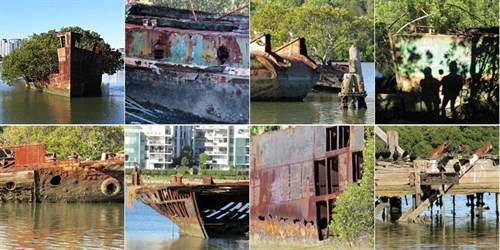Discovering Sydney’s hidden shipwrecks and mangroves

Robyn Kennedy loves to explore and photograph Sydney and surrounds. Her blog Life Out & About has become a passion, sharing ideas for outings in and around Sydney - charming gardens, bush walks, art galleries and inspiring places to eat!
Scattered along the mangrove shores of the Parramatta River are a number of rusted and crumbling old shipwrecks. These are the remnants of the former ship-breaking yard of Homebush Bay. The SS Ayrfield would have to be the most well known and photographed wreck with its rusty hulk and huge cargo of mangrove trees, often reflected beautifully in the still and glassy waters of the bay. In fact, it was one of those images that inspired our outing. Although we didn’t have the ‘glassy waters’ to capture the perfect reflection, it was still wonderful to see the Ayrfield on a brilliant sunny day!
The area immediately adjacent to the river has been redeveloped as Bicentennial Park, where paths, boardwalks and cycling tracks wind their way through the park and the Badu Mangroves. Surrounded by the mangrove forest, and somewhat hidden from most visitors to the park is a thriving Waterbird Refuge, an added bonus when visiting the shipwrecks.
Shipwrecks of Homebush Bay

Shipwreck Graveyard – Homebush Bay. Image credit: Robyn Kennedy
We started our walk from the Badu Mangroves and finished at the SS Ayrfield shipwreck. Best access to the Badu Mangroves is adjacent to the last parking area in Bicentennial Park (P10f).
Shipwrecks Heroic, Karangi, Mortlake Bank and Ayrfield are visible from the walking-cycling track that winds its way through the Badu Mangroves and Waterbird Refuge. Some of the wrecks appear to be adrift within the mangrove forest, like lost souls unable to find their way out, left to perish in the muddy salty waters. I found the mangrove forest atmosphere to be a little eerie at times, although an ideal resting place for these rusted old hulks!
At the end of the Waterbird Refuge is an old wooden ship-breaking ramp with a viewing platform. From here you have a close up view of the Karangi, as well as views across the bay to Ayrfield and Mortlake Bank.
Ref: History of the Shipwrecks
1. Shipwreck – SS Heroic
Homebush Bay Shipwreck – SS Heroic. Image credit: Robyn Kennedy
It’s hard to tell where the tugboat SS Heroic finishes and the mangrove trees start, they appear to be as one! Viewed from the track and through the mangrove forest, this is the first shipwreck we sighted. We loved the character of this old wreck with its rotting timber and rusting hulk reflecting shades of copper in the surrounding waters.
2. Shipwreck – HMAS Karangi
Homebush Bay Shipwreck – HMAS Karangi. Image credit: Robyn Kennedy
The location of the steel boom defence vessel HMAS Karangi reminds me a little of being lost in the Amazon jungle! Run aground within the mangroves and unable to escape, this hulk lays decaying in the mangrove forest mud.
3. Shipwreck – SS Mortlake Bank
Homebush Bay Shipwreck – SS Mortlake Bank. Image credit: Robyn Kennedy
While other wrecks lay hidden in the mangrove forest, the steam collier SS Mortlake Bank sits proudly on the bay. We viewed the wreck from the viewing platform near the Karangi. The cargo of weeds and grass was glowing brilliantly in the afternoon sun. If you walk beyond SS Ayrfield you may find better views from further around the bay.
4. Shipwreck – SS Ayrfield
Shipwreck – SS Ayrfield. Image credit: Robyn Kennedy
For the best views of the steam collier SS Ayrfield, follow the walking track through the Badu Mangroves, past the Waterbird Refuge. When the track meets Bennelong Parkway, turn right and cross the bridge. On the far side of the bridge there’s a path to the right that follows the waterway to the bay… continue along this path for a few minutes and the view above will be yours!
If you prefer to take the easy option, drive to the Archery Centre car park on Bennelong Parkway and access the same path mentioned above. There may also be another path directly opposite the car park that leads down to the waters edge.
Waterbird Refuge
The main reason for visiting the area was to see the shipwrecks, however the Waterbird Refuge was definitely another highlight of our outing… an excellent location for bird watching in Sydney.
Waterbird Refuge at Homebush Bay. Image credit: Robyn Kennedy
After following the Badu Mangroves track for 10 or so minutes we came across the first bird hide, where we were able to view large flocks of birds resting and feeding around the lake. The water was heavily carpeted in what appeared to be a bright yellow algae. With the lake edge covered in brilliant gold and pink grasses it really was a beautiful site in the late afternoon light, especially with the water reflecting a silvery blue. It was hard to believe we were in the heart of Sydney!
The Badu Mangroves
Badu Mangroves at Homebush Bay. Image credit: Robyn Kennedy
As well as providing a resting place for some of the old shipwrecks, the Badu Mangroves form a protective layer around the waterbird refuge. The walking-cycle track through the mangroves is very peaceful… there were only a handful of cyclists and walkers when we visited.
Unfortunately we didn’t have time to explore the zigzag boardwalk through the mangroves, however we did venture far enough to recognize that we wanted to return to do this walk – maybe at high tide when the water is lapping below the boardwalk.
Have you ever explored this interesting part of Sydney?
Hero image credit: Robyn Kennedy
